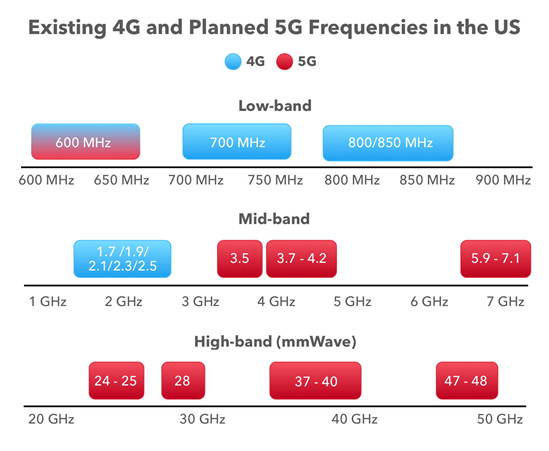Why Do We Need 5G?
Through the last few decades, with the rise of cellular technology our demands of connectivity have evolved. With the inception of 1G, operating on the 800Mhz band focusing on carrying voice data vast distances, to 4G and 5G have complex multi-band networks operating on many frequencies at the same time. The speeds and information broadcasted wirelessly has grown exponentially.
The reason for needing an upgraded fifth generation (5G) of network is to support the growing number of devices that demand internet access. Many of them requiring so much bandwidth in order to function normally that 4G simply doesn't cut it anymore. When 4G was getting rolled out in 2010 the average person had 1.8 internet connected devices, in 2020 the average person has 6.6 connected devices. This number is set to grow over the next decade again. 5G technology lays the framework to allow us to scale for the future and meet current infrastructure demands.
5G will have 3 layers – the coverage layer (low-band) sub 1GHz, the capacity layer (mid-band) 1-6GHz and the high throughput layer (mmWave) 6-300GHz. This is different to wireless technologies before it, 4G did this in a limited capacity but 5G takes this to a whole new level.

The big fundamental difference is 5G’s use of unique radio frequencies to achieve what 4G networks cannot. 4G networks use frequencies below 6 GHz, the bandwidth ranges from 700Mhz to 3Ghz. 5G’s range is drastically bigger, going from 600Mhz to 300 GHz range.
The explanation for how 5G achieves this is a bit too complex for this blog. An oversimplification is that by having a combination of bands that are high and low, along with advanced antenna technology, 5G can achieve it’s speeds. 5G uses shorter wavelengths, which means that antennas can be much smaller than existing antennas while still providing precise directional control. One base station can utilize even more directional antennas, this results in 5G supporting 1,000 more devices per meter than what’s supported by 4G in broad strokes.
These high frequencies are great for several reasons, one of the most important being that they support a huge capacity for fast data. Not only are they less cluttered with existing cellular data, they can also be used in the future for increasing bandwidth demands.
|
Why does the IOT revolution Need 5G
|
The IoT revolution depends on having infrastructure that can power thousands of low powered devices. These devices need to operate over vast distances and in general terms only need to send and receive small packets of data. This volume of devices could clog 4G frequencies thus costing more to support at a telecommunication level. The low-band 5G frequencies are designed with this in mind.
These frequencies are also relatively unclogged resulting in telecommunication businesses having the ability to sustain connectivity in these bands for a fraction of what it would cost to support a device in the very clogged 4G space.
‘The Low-band frequencies setup with 5G range in mind will be the pillar of IoT Networks’
The 5G coverage layer or low-band that ranges from 200Mhz to about 900Mhz ticks all the boxes for IoT connectivity. The range of one 200Mhz antenna can be as high as 50km but can only send very small packets of information over that distance (around 100 bytes).
Next week we will discuss a key connectivity technology called LPWAN that the most popular IoT communication networks use to send and receive information.
Quadrent provides hassle free technology leasing to help companies achieve their most ambitious goals, whether that be supercharging their current workflows with an IoT infrastructure or empowering staff with . We’d love to have a chat about technology goals. Reach out to Arnold here.
